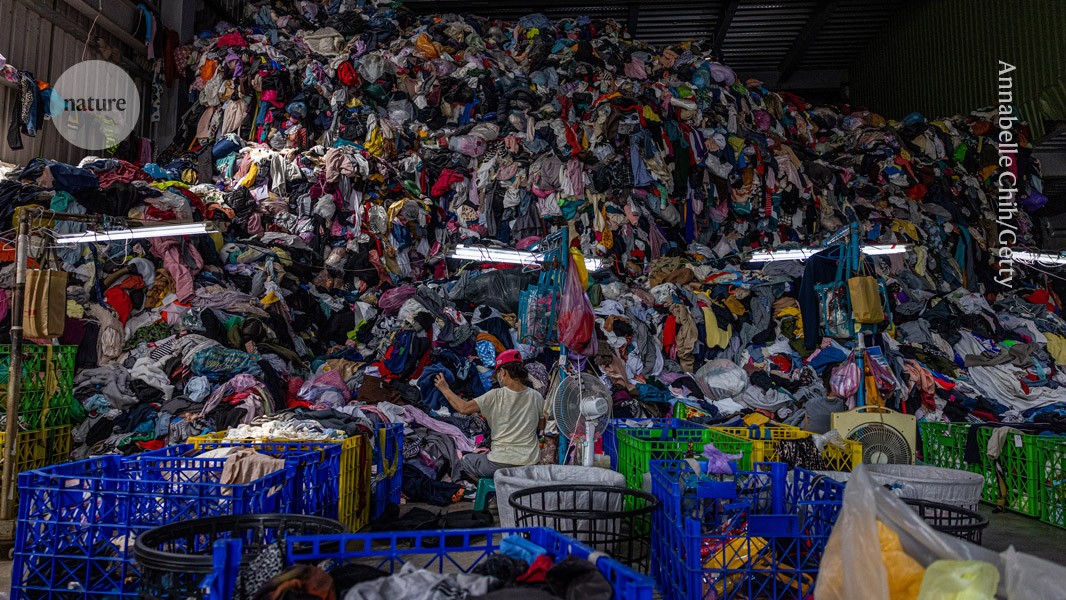‘Chemical recycling’: 15-minute reaction turns old clothes into useful molecules

Fast fashion creates millions of tonnes of waste each year — could clever chemistry help to tackle the problem?

Piles of discarded clothes wait to be sorted at a textile-recycling factory in Taiwan.Credit: Annabelle Chih/Getty
Researchers have developed a chemical-processing technique that can break down fabrics into reusable molecules, even when they contain a mixture of materials.
The process, outlined in a Science Advances paper on 3 July1, shows that chemical recycling can give old textiles a new lease of life. If scaled up, it could help to tackle the growing mountain of waste generated by the fashion industry, says study co-author Dionisios Vlachos, an engineer at the University of Delaware in Newark.
Estimates suggest than less than 1% of textiles are recycled, and nearly three-quarters of used garments end up incinerated or dumped into landfill. “A good third or more of the microplastics that end up in the ocean” come from clothing, says Vlachos. “Our ability to develop technology to be able to handle all this waste and remove them from the environment, landfills and the oceans is very important.”
Miriam Ribul, who researches sustainable materials at the UKRI Textiles Circularity Centre, says that although recycling should be regarded as a last resort after repairing and reusing old clothes, the industry would welcome “investment in these new processes and technologies to be able to scale up”.
Tricky textiles
Much recycling involves physically separating waste into raw materials, but this approach has shortcomings when it comes to dealing with textiles. Many fabrics are made of a mixture of materials, for example cotton blended with synthetic fibres such as polyester. Mechanical recycling techniques struggle to separate multi-fibre textiles into products that can be used again. “The quality of what you get is reduced,” says Vlachos.
The researchers instead turned to chemical recycling to break down some synthetic components of fabrics into reusable building blocks. They used a chemical reaction called microwave-assisted glycolysis, which can break up large chains of molecules — polymers — into smaller units, with the help of heat and a catalyst. They used this to process fabrics with different compositions, including 100% polyester and 50/50 polycotton, which is made up of polyester and cotton.
For pure polyester fabric, the reaction converted 90% of the polyester into a molecule called BHET, which can be directly recycled to create more polyester textiles. The researchers found that the reaction didn’t affect cotton, so in polyester–cotton fabrics, it was possible to both break down the polyester and recover the cotton. Crucially, the team was able to optimise the reaction conditions so that the process took just 15 minutes, making it extremely cost-effective. “Typically, these things take days to break them down. So, going down from days into a few minutes, I think this is a major renewal,” Vlachos says. Eventually, he says, “I think we can actually go down into seconds”.
Scaling up
The study also investigated how other material combinations respond to the reaction process. The results were good even when textiles contained unknown proportions of fibres including cotton, polyester, nylon or spandex. Spandex broke down into a useful molecule called MDA, and nylon, like cotton, could be extracted intact. However, some polyester materials produced reduced levels of BHET, including dyed fabrics and those that had been treated to be resistant to ultraviolet light or fire. The team suggests that further research is needed to optimise conditions for such materials.
In an analysis as part of their study, Vlachos and his colleagues estimated that, with further development, 88% of clothing worldwide could be recycled.
“We have a simple process that we can scale to treat large quantities of clothing,” says Vlachos. “We are very optimistic that this can actually be taken to the real world.”
doi: https://doi.org/10.1038/d41586-024-02210-1
This story originally appeared on: Nature - Author:Helena Kudiabor


















